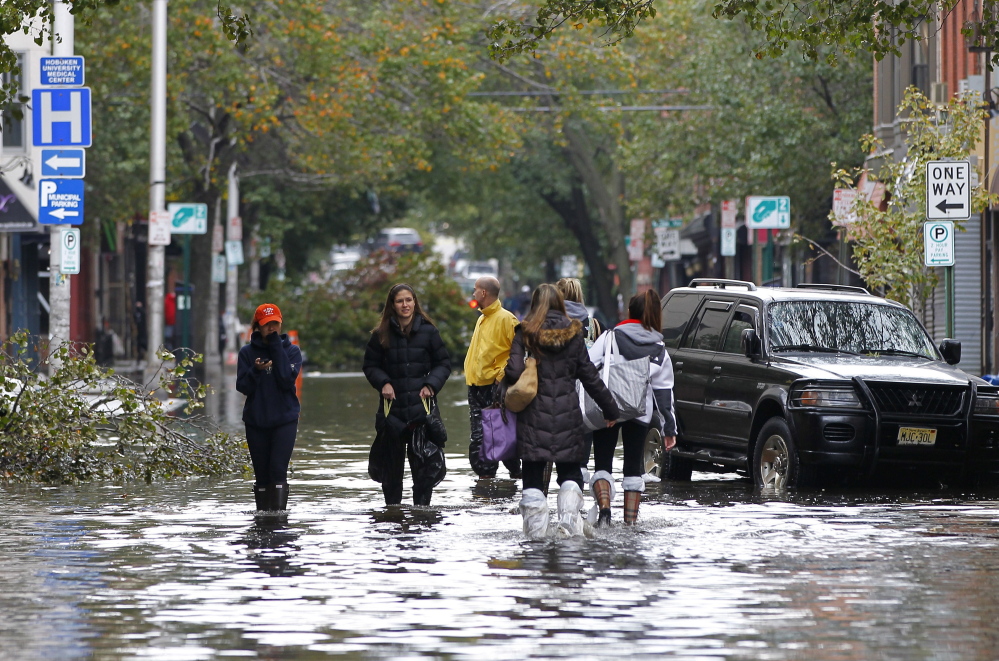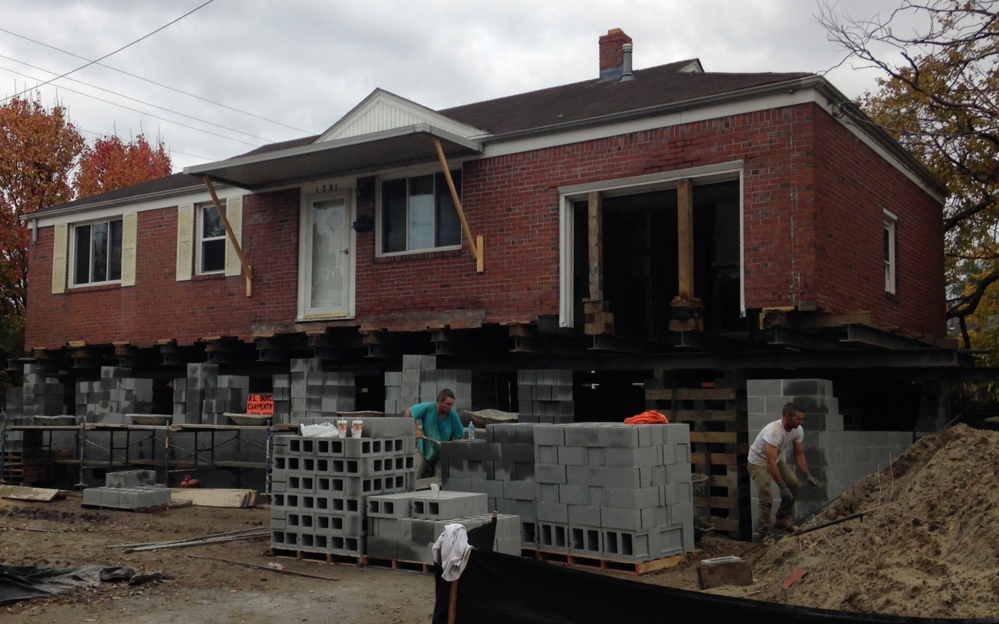Amanda Armstrong schedules her life around the tides. For the past 1 1/2 years, she’s had to navigate rising waters that saturate the lawn of her red brick house in Norfolk, Virginia, and sometimes fill a puddle out front with crabs and fish.
“We call it our little aquarium,” Armstrong, 40, said from outside the home along the Lafayette River that she rents with her family, where wetlands plants have sprouted up from the frequent doses of salt water.
Climate change is beginning to take a toll on real estate in the coastal city, about 80 miles southeast of Richmond, as insurance costs soar and residents resort to putting their homes on stilts or opening up space underneath for the water to flow through. While most of the U.S. is in a housing rebound, prices in Norfolk fell 2.2 percent in October, according to the Virginia Beach-based Real Estate Information Network.
The city, which averages about a flood a month, is a harbinger of life in U.S. coastal communities. By 2045, within the lifetime of a 30-year mortgage, sea levels will rise about a foot along the Gulf of Mexico and the eastern shoreline, increasing tidal flooding in places including Atlantic City, New Jersey; Ocean City, Maryland; and Myrtle Beach, South Carolina, according to an October report by the Union of Concerned Scientists.
“Even with gradual sea-level rise, some elevations can undergo very fast change in vulnerability to flooding,” said Ben Strauss, vice president for sea level and climate impact at research organization Climate Central. “What’s happening in coastal Virginia is kind of a preview of what could happen much more widely.”
COST OF STORMS IS RISING
Higher sea levels combined with storm surges, in which high winds and low pressure carry sea water inland, will probably increase the average annual cost of coastal storms in the region by as much as $3.5 billion within the next 15 years, according to a June report from the Risky Business Project, an effort to highlight the economic costs of runaway climate change led by former Treasury Secretary Henry Paulson, hedge-fund manager Tom Steyer and Michael Bloomberg, the founder and majority owner of Bloomberg News parent Bloomberg.
With potential increases in the number and intensity of hurricanes, the total annual price tag for coastal storms will increase to about $35 billion, the report showed.
In the Northeast, the effects are still being felt from Hurricane Sandy two years ago.
Sandy brought hurricane-force winds and pushed floodwaters over barrier islands and into seaside communities, destroying or damaging 305,000 homes in New York and 346,000 in New Jersey. It led to mortgage delinquencies in Long Island, New York, waterfront communities such as Mastic Beach and Shirley, where many owners abandoned properties because they couldn’t afford the repairs.
“Things are not that much better,” said Ed Romaine, supervisor of neighboring Brookhaven, and its former commissioner of housing and community development. “Some people are getting some FEMA aid; some people have left their homes vacant.”
Home prices in Mastic Beach, a 30-minute drive west of the Southampton mansions on Long Island’s southern coast, have dropped more than 9 percent to $162,000 in October from the same month in 2011, before Sandy hit, according to Zillow.
Along the Virginia coast, flooding has become such a part of everyday life that residents are raising their properties about 10 feet off the ground, towering over neighbors atop gray cinder block beds. It costs from $80 to $100 a square foot, and takes about two to four months to lift a home and complete the construction underneath, according to Jim Matyiko, who co-runs the Southeast division of Expert House Movers.
The structural moving company elevates one or two homes each week in the Virginia coastal area, Matyiko said. About 80 percent are lifted with aid from the Federal Emergency Management Agency.
Poquoson, a Virginia bedroom community of about 4,055 houses, this year got approval for its second hazard-mitigation grant from FEMA to help lift about 20 homes in the area, according to Kenneth Somerset, the city’s floodplain manager.
“The ones down low are in the minority now,” Somerset said.
Raised homes are more valuable and easier to sell, because flood insurance premiums are lower and buyers don’t have to factor in future flood mitigation costs, according to Somerset.
Poquoson prices in October were up almost 9 percent from a year earlier, Real Estate Information Network data showed.
While it keeps the interiors dry, some houses cost more to raise than they are worth, said Skip Stiles, executive director of Wetlands Watch, a Virginia nonprofit environmental group.
In Norfolk, where there is little land to develop, the city wants homes raised anyway to protect its property-tax base, he said, standing in the Larchmont neighborhood, where a masonry crew last month was building a new foundation under a small brick house with white shutters. Two days later, with the help of winds from a nor’easter, the street flooded, preventing construction workers from getting to the home.
“It shows the folly of raising a house and forgetting about the street or future conditions,” Stiles said. “This is what we’ll be getting regularly by about 2070.”
‘REPETITIVE LOSSES’ MOUNT
The majority of houses nearby, lining Hampton Boulevard, are still sitting at street level.
Many owners can’t afford to lift their houses without federal aid, and the damage from flooding continues to increase. There are 900 Norfolk properties on the “repetitive loss” list, up from 200 in 2002, according to a November Wetlands Watch study. Some people try to rent their homes or walk away from them if they can’t sell, Stiles said, pointing to one of several “for sale” signs in the neighborhood.
“They come up like mushrooms after the storms,” he said.
Escalating flood-insurance costs in Norfolk and surrounding areas have been making it harder for residents to buy and sell homes, according to Scott Hunter, owner of Virginia Beach-based Comparity, which helps people shop for insurance plans.
“It definitely has impacted real estate,” Hunter said. “It’s a combination of longer selling times for homes in required zones with expensive policies and buyers that are in a situation where the deal can’t go through because of the added flood expense.”
Michael Vernon, director of business development for Flood Mitigation Hampton Roads, has built a business around the encroaching waters, helping homeowners prevent flooding and lower insurance costs, which makes their properties more attractive to buyers. One of his clients was struggling to sell a house in Virginia Beach that had been listed on the market for about 60 days. The flood-insurance premium cost $1,800 a year, he said.
The owner paid about $2,300 in August for Vernon’s team to put vents in the house to allow for water to flow in and out of the crawl space beneath it. The work brought the annual insurance down to $400, and the house sold five days later.
Send questions/comments to the editors.




Success. Please wait for the page to reload. If the page does not reload within 5 seconds, please refresh the page.
Enter your email and password to access comments.
Hi, to comment on stories you must . This profile is in addition to your subscription and website login.
Already have a commenting profile? .
Invalid username/password.
Please check your email to confirm and complete your registration.
Only subscribers are eligible to post comments. Please subscribe or login first for digital access. Here’s why.
Use the form below to reset your password. When you've submitted your account email, we will send an email with a reset code.